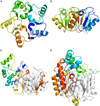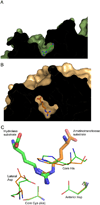Mechanistic similarity and diversity among the guanidine-modifying members of the pentein superfamily
- PMID: 20654741
- PMCID: PMC4104755
- DOI: 10.1016/j.bbapap.2010.07.016
Mechanistic similarity and diversity among the guanidine-modifying members of the pentein superfamily
Abstract
The pentein superfamily is a mechanistically diverse superfamily encompassing both noncatalytic proteins and enzymes that catalyze hydrolase, dihydrolase and amidinotransfer reactions on guanidine substrates. Despite generally low sequence identity, they possess a conserved structural fold and display common mechanistic themes in catalysis. The structurally characterized catalytic penteins possess a conserved core of residues that include a Cys, His and two polar, guanidine-binding residues. All known catalytic penteins use the core Cys to attack the substrate's guanidine moiety to form a covalent thiouronium adduct and all cleave one or more of the guanidine C--N bonds. The mechanistic information compiled to date supports the hypothesis that this superfamily may have evolved divergently from a catalytically promiscuous ancestor.
Copyright © 2010. Published by Elsevier B.V.
Figures








Similar articles
-
Promiscuous partitioning of a covalent intermediate common in the pentein superfamily.Chem Biol. 2008 May;15(5):467-75. doi: 10.1016/j.chembiol.2008.03.012. Chem Biol. 2008. PMID: 18482699 Free PMC article.
-
Evolutionary genomics of the HAD superfamily: understanding the structural adaptations and catalytic diversity in a superfamily of phosphoesterases and allied enzymes.J Mol Biol. 2006 Sep 1;361(5):1003-34. doi: 10.1016/j.jmb.2006.06.049. Epub 2006 Jul 7. J Mol Biol. 2006. PMID: 16889794
-
A global view of structure-function relationships in the tautomerase superfamily.J Biol Chem. 2018 Feb 16;293(7):2342-2357. doi: 10.1074/jbc.M117.815340. Epub 2017 Nov 28. J Biol Chem. 2018. PMID: 29184004 Free PMC article.
-
Enzyme promiscuity: a mechanistic and evolutionary perspective.Annu Rev Biochem. 2010;79:471-505. doi: 10.1146/annurev-biochem-030409-143718. Annu Rev Biochem. 2010. PMID: 20235827 Review.
-
Structure and function of the LmbE-like superfamily.Biomolecules. 2014 May 16;4(2):527-45. doi: 10.3390/biom4020527. Biomolecules. 2014. PMID: 24970229 Free PMC article. Review.
Cited by
-
Citrullination Was Introduced into Animals by Horizontal Gene Transfer from Cyanobacteria.Mol Biol Evol. 2022 Feb 3;39(2):msab317. doi: 10.1093/molbev/msab317. Mol Biol Evol. 2022. PMID: 34730808 Free PMC article.
-
Short-Term Supplementation of Sodium Nitrate vs. Sodium Chloride Increases Homoarginine Synthesis in Young Men Independent of Exercise.Int J Mol Sci. 2022 Sep 13;23(18):10649. doi: 10.3390/ijms231810649. Int J Mol Sci. 2022. PMID: 36142560 Free PMC article. Clinical Trial.
-
On the mechanism of dimethylarginine dimethylaminohydrolase inactivation by 4-halopyridines.J Am Chem Soc. 2011 Jul 20;133(28):10951-9. doi: 10.1021/ja2033684. Epub 2011 Jun 23. J Am Chem Soc. 2011. PMID: 21630706 Free PMC article.
-
Protein Arginine Methylation and Citrullination in Epigenetic Regulation.ACS Chem Biol. 2016 Mar 18;11(3):654-68. doi: 10.1021/acschembio.5b00942. Epub 2015 Dec 31. ACS Chem Biol. 2016. PMID: 26686581 Free PMC article.
-
Deep Learning Enhances Precision of Citrullination Identification in Human and Plant Tissue Proteomes.Mol Cell Proteomics. 2025 Mar;24(3):100924. doi: 10.1016/j.mcpro.2025.100924. Epub 2025 Feb 5. Mol Cell Proteomics. 2025. PMID: 39921205 Free PMC article.
References
-
- Groft CM, Beckmann R, Sali A, Burley SK. Crystal structures of ribosome anti-association factor IF6. Nature Structural & Molecular Biology. 2000 Dec;7:1156–1164. - PubMed
-
- Paoli M. An elusive propeller-like fold. Nature Structural Biology. 2001 Sep;8:744–745. - PubMed
-
- Teichmann SA, Murzin AG, Chothia C, Determination of protein function. evolution and interactions by structural genomics. Current Opinion in Structural Biology. 2001 Jun;11:354–363. - PubMed
-
- Hartzoulakis B, Rossiter S, Gill H, O’Hara B, Steinke E, Gane PJ, Hurtado-Guerrero R, Leiper JM, Vallance P, Rust JM, Selwood DL. Discovery of inhibitors of the pentein superfamily protein dimethylarginine dimethylaminohydrolase (DDAH) by virtual screening and hit analysis. Bioorganic & Medicinal Chemistry Letters. 2007 Jul;17:3953–3956. - PubMed
-
- Groft CM, Beckmann R, Sali A, Burley SK. Crystal structures of ribosome anti-association factor IF6. Nature Structural Biology. 2000 Dec;7:1156–1164. - PubMed
Publication types
MeSH terms
Substances
Grants and funding
LinkOut - more resources
Full Text Sources

